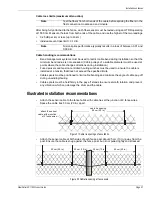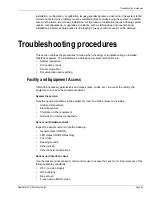
Buried cable installation
FiberPatrol FP1150 Product Guide
Page 55
1.
Measure and mark the mounting hole locations on the surface.
2.
Using a 5/32 carbide-tipped bit, drill the mounting holes 1 1/2 in. deep.
3.
Once the holes are drilled, use compressed air to blow out any residue.
4.
Fit a P-clamp over the sensor cable and pinch the ends together with your fingers so the 2
holes line up.
5.
Use lineman pliers to squeeze the bracket together at the sensor cable end of the clamp.
6.
Fit a 3/16 in. X 1 1/4 in. Tapcon screw through the 2 holes and fasten the P-clamp to the
mounting surface with a power driver.
Do not over-tighten to avoid stripping or shearing the screws. The sensor cable should be
manually tensioned as it is being clamped and fastened to keep it straight and taut. Installed
sensor cable must not sag or touch the surface.
Buried cable installation
There are ten steps required to complete a FiberPatrol buried cable installation:
1.
Create a detailed site plan and obtain the required components.
2.
Deploy the sensor cable according to the site plan.
3.
Make any required field splices (excluding the end module and start module splices).
4.
Use an OTDR to measure the loss in each spliced fiber from both ends of the sensor cable
before making the splices to the end module and start module.
5.
Install and connect the control room equipment.
6.
Make the fusion splices for the sensor unit and end module.
7.
Set up and configure the system software.
8.
Bury the sensor cable.
9.
Calibrate the system.
10. Test the system to ensure it meets the site’s detection requirements.
Laser light safety
Optical fiber safety
Note
Mark the desired hole depth on the bit with a piece of colored tape.
WARNING
FiberPatrol operates with Class 1 laser light levels.
Do not look directly into the end of a fiber connector.
Ensure that the fiber optic light source is off, before using a scope to
check a fiber optic connector.
WARNING
Use care when working with exposed optical fibers. The bare fibers are
125 microns in diameter and can easily penetrate skin.
Always wear safety glasses when working with optical fibers.
Always dispose of fibers in a sealed and labeled container that is
specifically designed to contain fiber optic waste.
NEVER dispose of bare fibers in a standard waste receptacle.






























